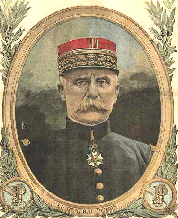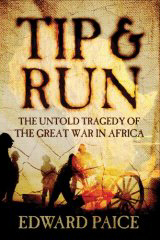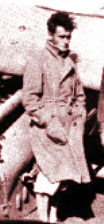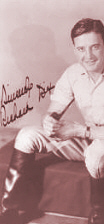
May 2007 |
Access Archives |
TRENCH REPORT:Greetings. May's Trip-Wire has been delivered to you a little early because on April 28th I'm off the the Western Front to lead Valor Tour's 2007 WWI group trip. Plus: I have another surprise for our regular readers. My old, decrepit computer system needs replacement. I have ordered a new Dell system to be delivered shortly after my return. If all goes smoothly, next month's issue should be available on schedule. However, I am a bit concerned that the software and files I've come to rely on for almost a decade can be used with the new Windows Vista operating system, which is a technological quantum leap for me. We will be back in touch soon, though, one way or the other. MH
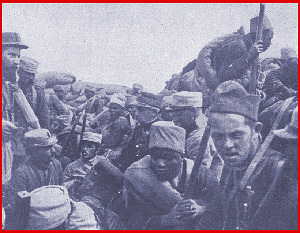 French Officers & Colonial Troops
|
||||||||||||||||||||||||||||||||||||||
New at Our Own & Our Friends' Great War WebsitesClick on Title to Access |
|
At Great War Society Sites At the WFA-USA |

In WWI, only one per thousand draftees in the German army was illiterate -- itself an astonishing fact -- as against 68 per thousand in the French army and 330 per thousand in Italy's.
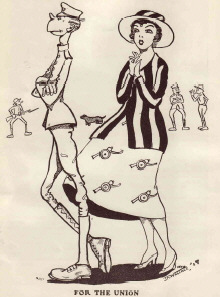
Cartoon from the Stanford University magazine, The Chapparal, May 1917
Victoria: I just hate war and fighting!
Victor: Well let's just go see the justice of the peace.

'Les chose ne peuvent ne pas s'arranger'
Things must turn out all right.
Jean Jaurès
Shortly before his assassination
on the eve of war.
Fort Dix will celebrate its 90th Birthday July 18. The post opened in 1917 as Camp Dix for training soldiers for the American Expeditionary Force. They are seeking any World War I reenactors or vintage vehicle collectors who might want to join us for the celebration. Contact their Public Affairs Officer, Carolee J. Nisbet.
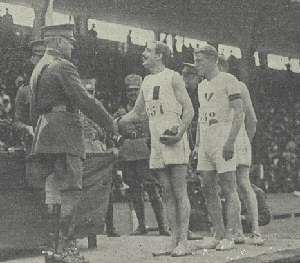
General Pershing Congratulating the French Cross Country Champion at the 1919 Inter-Allied Games in Paris (At Pershing Stadium!)
| The Price of War: Over 330,000 Australian Diggers served in their nation's expeditionary force, and 226,000 became casualties, including 59,258 who were killed. This recent Anzac Day (April 25th) was only the second to be celebrated without a single surviving Digger. |
|
German Soldier by Crown Prince Wilhelm, c. 1915 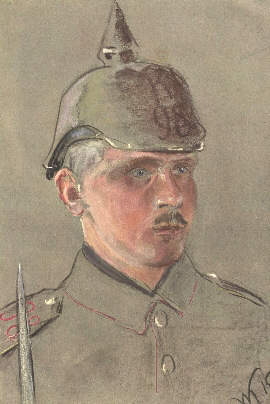
|
GREAT WAR 2007 EVENT CALENDAR | |
|
League of World War I Aviation Historians May 11-12, 2007 Holiday Inn Rosslyn in Arlington, VA (link) | |
|
Palestine Campaign International Conference September 3-6, 2007 Tel-Hai Academic College in Upper Galilee, Israel (email for details) | |
|
Each Other For WFA-US.A 18th National Seminar September 7-9, 2007 Naval War College Newport, RI (Full Program) | |
|
The Huntington Library, October 5-6, 2007 San Marino, CA (email for info.) | |
|
International Conference October 18-20, 2007 Georgetown University, Wash., D.C. (link) | |
|
U.S. Branch Chapter Meetings Check for Your Region Regularly Updated (details) | |
|
Berkeley, San Francisco and Palo Alto, CA Regularly Updated (details) | |
|
Email Response |
|
|
WWI Music
I get a lot of requests for information on purchasing WWI music. Here is a new 2-CD Music set I'm bringing along to play for my fellow travelers on my Western Front tour. Unlike other such collections, it has a strong American component including Al Jolson and Enrico Caruso's multi-language rendition ofOver There. Click on the image for ordering information.
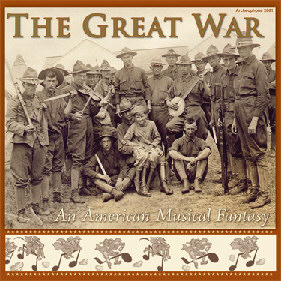
The Joliet (Illinois) Area Historical Museum is presenting "Songs of the Patriot," a varied and colorful collection of World War I era sheet music covers, from April 6 to July 8.
Also, reader/contributor Len Shurtleff has recommended an addition to last month's list of classical music inspired by the Great War: Igor Stravinsky's L'Histoire du Soldat ("A Soldier's Tale"), a narration with music composed in 1918 at the outset of Stravinsky's (The Firebird, The Rite of Spring) exile from Russia.
The Descendents and Friends of the 314th Infantry (79th Division, AEF) has announced their 86th annual Memorial Day service at Washington Memorial Chapel, Valley Forge, PA., Sunday May 27th at 2:00 P.M. Their speaker this year is Colonel Robert J. Dalessandro, Director of the U.S. Army Heritage and Education Center.
Click Here for News on Travel Opportunities |
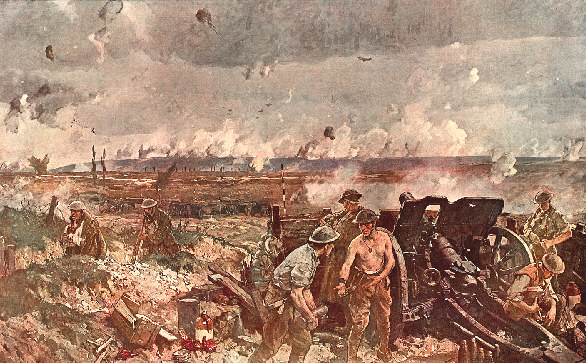
The Battle of Vimy Ridge (after Richard Jack), 1917
(See News Stories About Last Month's Rededication of the Vimy Memorial Below)

Lloyd Brown, the last known surviving World War I U.S. Navy veteran, died on Thursday in Charlotte Hall Veterans Home in Maryland. He was 105. (link)
| |
|
VA Searching for Last Doughboys of World War I Only Four Believed Still Alive WASHINGTON (April 4, 2007) -- With the number of known living American veterans of World War I now standing at four, the Department of Veterans Affairs (VA) is seeking public assistance in determining whether others are still alive. "These veterans have earned the gratitude and respect of the nation," said Secretary of Veterans Affairs Jim Nicholson. "We are coming to the end of a generation that helped bring the United States to the center of the international arena." The four known surviving World War I veterans are John Babcock, 102, from Puget Sound, Wash.; Frank Buckles, 106, Charles Town, W.Va.; Russell Coffey, 108, North Baltimore, Ohio; and Harry Landis, 107, Sun City Center, Fla. Babcock is an American who served in the Canadian Army. The other three survivors were in the U.S. Army. |
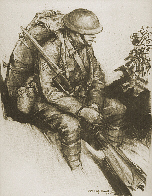 |
 |
WWI Claims Another Victim
By Christina Holstein
At the end of March, an explosion in a quiet street in Verdun killed a young man of 21. He was handling a German 17cm trench mortar shell when the fuse detonated, blowing off his leg and burning him severely. When the emergency services arrived, they found that the garden shed in which the young man was lying was literally paved with scores of other live shells and that he had, in addition, a substantial collection of other battlefield debris, including grenades, rifles and fuses. The amount of ammunition removed from the garden by the French army bomb disposal service was two and a half tons!

Artillery Shells Recently Discovered at Mort Homme, NW of Verdun
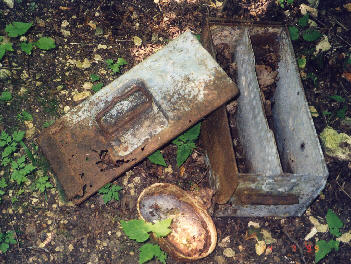
Other Artifacts Like This Ammo Box and Mess Kit are Still Found on the Battlefields
A Sad Footnote: [Received from Christina After She Had Submitted the Piece Above:
There was some sad news today (April 18, 2007). Two members of the French Army bomb disposal service were killed today, 18th April, in the explosion of WWI shells at Pont-à-Mousson, eastern France, that were being prepared for transfer to the French army camp at Suippes, where they were to be destroyed. Both men were involved in removing the shells from the house of the young man killed in Verdun at the end of March.
 Erich Ludendorff |
|

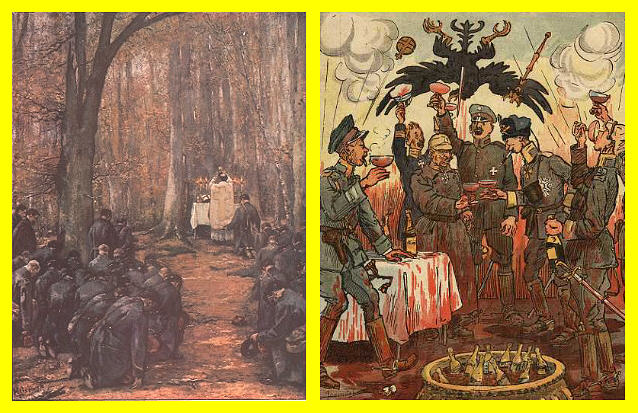
Interesting Contrast from Contemporary French Periodicals:
Pious French Soldiers at Mass in the Argonne vs. The Blood-Stained German Debauchers
 |
1917 on The Western Front | |
|
They were coined as "acts of collective indiscipline". Various units with very good fighting records had come back from the blazing front in a state of moral disintegration towards the end of April. On 29th April the first mutiny was reported by the 2nd Battalion of the 16th Infantry Regiment. They had been reduced from a nominal 600 men to only 200 by the morning after the assault, and were marched back to their miserable billets in Soissons where their comfort was generally ignored. So they drifted, unwanted, and with the rumours floating that they would be transferred to a 'quiet' front in Alsace. On 29th April they were ordered back to the front. They refused but after midnight were somehow led back to the front by the Colonel appealing to them 'On behalf of your mates already at the Front'. The Military Police picked out a number of men reputed to be ringleaders, and in short order the majority were sentenced to imprisonment in French Guinea -- a death sentence in that disease-ridden place. Five men were sentenced to be shot, and sentence was carried out on June 12th. Notwithstanding the speed at which this mutiny was suppressed, others immediately followed it, these actions accelerating into May with no end in sight. At this time there were about 1000 battalions in the French Army, and it was eventually thought that at least half of them could not be trusted to go into action, although it was thought they would hold the trenches--but no more. In my personal opinion these "acts of collective indiscipline" were brought about by the many broken promises to the troops, bad battle management leading to frightening losses amongst the infantry ever since 1914, and senior staff incomprehension of the living conditions of the French private soldier (the Poilu) or of their need for comfort when in rest and out of the line. Nivelle was acrimoniously fired after accusing his senior army commanders of mismanagement despite their advising him previously of their fears for the campaign. He was replaced in May by General Petain who then had the terrible job of restoring hope and morale to the ailing French army. He did this brilliantly and managed to restore an element of trust in the average Poilu, due to his long association with the fighting men. He introduced proper leave rosters, proper rest camps, proper food facilities, allowed junior officers to report up the chain of command so that their (junior) voices could be heard, and allowed the Colonels of the Regiments to carry out such sentences against known mutineers as they deemed necessary. Later that year, he actually managed to launch various 'set piece' attacks, notably to extend the French lines away from Verdun in the summer and to clear Fort Malmaison at the west end of the Chemin des Dames in October. He accepted that the French army was in no mood to launch any more large-scale assaults but knew that the men would "hold the line" to the best of their ability. |
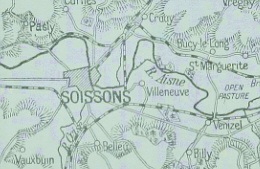 "Ground Zero" for the MutiniesPreviously, in April and then in May, the Australians tried to break the Hindenburg line opposite the village of Bullecourt, not far from Arras. Despite absolutely valiant efforts, they were not successful and again suffered heavy casualties. Even today, a walk over this small battlefield shows what a daunting problem they had. The sunken road which was the German front line is still there, as is the (now derelict) railway line that was the Australian start line. 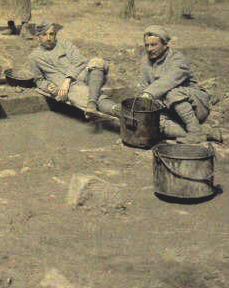 French Troops Near Soissons | ||||||
| In September 1917 the British Army also experienced some "collective indiscipline" at the Etaples base camp near Boulogne, notorious among the troops for the heavy-handed training methods used there. |
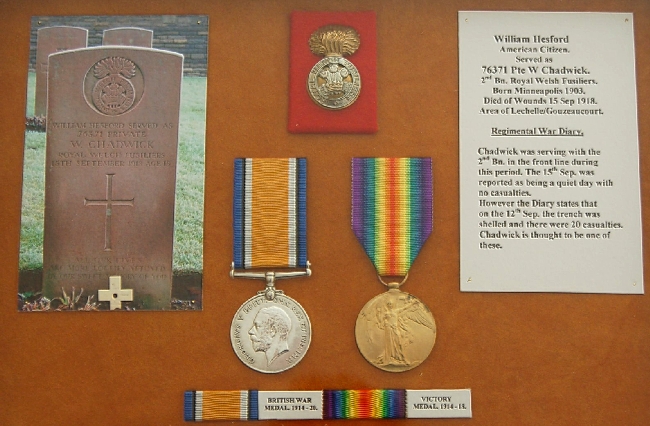 A display gathered for the Hesford family by our friend, ace researcher and frequent contributor Sidney Clark. William Hesford's family had read about Sidney's discovery of the very young Yank's service in the British Army on the Trip-Wire. Check William's age at his death. |
 |
Our Interview Series With
|
We asked our frequent contributor Len Shurtleff, who--as you will see--is extremely well versed in African affairs to interview Mr. Paice for our readers. Click here to read the interview. |
|
in the 21st Century |
- Queen Elizabeth Rededicates Vimy Ridge Memorial on Battle's 90th Anniversary
- Canadian Students Travel to Vimy
- Canadian Troops in Afghanistan Mark Vimy Ridge
- Labor of Love: Rebuilding the Vimy Memorial
|
|
When Saunders wrote the original story for Wings, the first epic of the fliers of World War I, it was Saunders's first major story credit in Hollywood and set him up as one of the men who could "write gutsy, ballsy stories" according to Warner Bros. studio head Jack Warner. Wings was a breakthrough for Saunders. But his most important film credit came in 1930 with an 11-page story, "The Flight Commander." Howard Hawks directed the movie The Dawn Patrol based on the story, and the movie became a classic. Saunders was a full-fledged member of what was called "The Lost Generation" - a glamorous, good-looking young man of refined breeding and excellent education who drank a lot and had a strong self-destructive streak. He had a reputation as a womanizer, and one night Zelda Fitzgerald volunteered to castrate him with a pair of editor's shears! He and Wray finally divorced with William J. "Wild Bill" Donovan of "The Fighting 69th" advising Wray on the separation and divorce. Saunders drifted away from Hollywood and in March 1940 was found hanged in a closet in Fort Myers, Florida. The view of the First World War as a horrific, man-devouring waste spread to movies about aerial combat. The war in the air was seen as harrowing as the war on the ground. Saunders supplied the stories for a number of films in which the air war is no longer filled with gallantry and fearless men. The fliers, constantly facing death, are afraid. Commanders are destroyed by their responsibilities. And everyone drinks to dull the pain. You might think that Saunders's stories could only have been told by someone with firsthand experience in France. But Saunders spent the war in the United States as a flight instructor, and the Armistice came before he was called to Europe. He was at a flying field in Florida as an instructor when he heard the war ended. That night he went to his plane, leaned against the propeller, and cried. Saunders heard a lot of war stories from British, Canadian, and French fliers while at Oxford, as well as from Yanks when he lodged at the American Flying Club in New York upon his return from Europe.
His fiancée encounters him when he's in Paris for some drinking and whoring. She doesn't like what she sees: the air war she has shamed him into joining has ruined him. He passes up his whoring to coerce her into spending the night with him. What a cad! While recovering from a minor wound Thorne finds himself in a hospital bed next to a young German cadet he shot down. The German has a painful stomach wound, and constantly screams for some forbidden water. The young cadet's hysteria and torment bring home the reality of killing. He eventually silences the wounded man by giving him water and effectively killing him. When Thorne looks at his box of medals he asks himself "Are these worth forty-two dead men? Are they worth one dead man?" When he goes up again, he's too haunted to fight back and is shot down. While Ace of Aces is not a masterpiece, it's entertaining and thought-provoking with a number of interesting touches. When Thorne is initially confronted by his fiancée in his studio he compares the soldiers marching outside his window to lemmings. She marks him with yellow chalk, signifying his cowardice. The pacifism of this and other 1930s war films is honest in depicting the unsettling effect that World War I had on American society. There's an honesty about war and its consequences that's absent from most American war films. Killing is viewed by Saunders as a primitive function, and the pilots in Thorne's squadron have pets that serve as totem animals as if they were tribal warriors. Significantly, Thorne's pet/totem animal is a lion, a killer beast. The other pilots have funny mascots- a pig, a parrot, a chimp, a dog.
Aircraft used in Ace of Aces include Waco 7s, Nieuport 28s, a Curtiss Jenny and a LF-1 (J-4 Wright-powered replica). It was filmed in the Trifuno Canyon area, now part of Thousand Oaks, California. Saunders's World War I and aviation-themed screenplays and stories include Wings (1927), Legion of the Condemned (1928), She Goes To War (1929), The Dawn Patrol AKA Flight Commander (1930) The Last Flight (1931), The Eagle and the Hawk (1933), Devil Dogs of the Air (1935), West Point of the Air (1935) and Conquest of the Air (1940). Andrew Melomet, Proprietor of Andy's Nickelodeon, will answer your Great War film or video inquiry. He is also soliciting your recommendations for the WWI Filmography he is compiling for our readers. Just click HERE. |
| The following are thanked for their contributions to this issue of the Trip-Wire: Donna Cunningham, Frank Jordan, Tony Langley, Christina Holstein, Tony Noyes, Andy Melomet, Kimball Worcester, and Len Shurtleff; the many of you who sent the items for "Gone West"; the Ontario Provincial Archives for the Vimy Ridge painting; and the Gutenberg Project for the Soissons map. Until next month, your editor, Mike Hanlon. | SUBSCRIBE TO THE TRIP-WIRE (Or send it to a friend) (Or send us a comment on the TRIP-WIRE) CLICK HERE TO CONTACT US VIA EMAIL |
For further information on the events of 1914-1918
and membership information visit the Directory Pages of:
|

